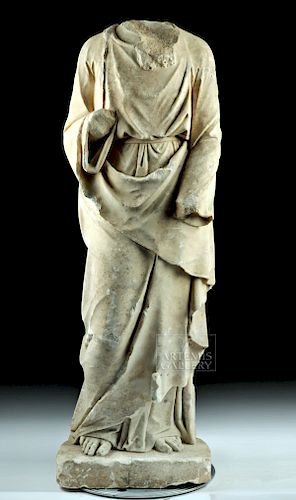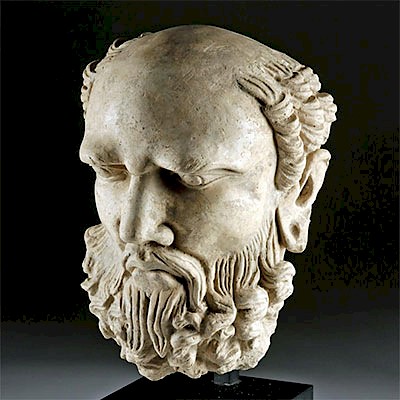Stunning 17th C. Neoclassical Marble Statue of Hades
Lot 328
About Seller
Artemis Fine Arts
686 S Taylor Ave, Ste 106
Louisville, CO 80027
United States
Selling antiquities, ancient and ethnographic art online since 1993, Artemis Gallery specializes in Classical Antiquities (Egyptian, Greek, Roman, Near Eastern), Asian, Pre-Columbian, African / Tribal / Oceanographic art. Our extensive inventory includes pottery, stone, metal, wood, glass and textil...Read more
Categories
Estimate:
$8,000 - $12,000
Absentee vs Live bid
Two ways to bid:
- Leave a max absentee bid and the platform will bid on your behalf up to your maximum bid during the live auction.
- Bid live during the auction and your bids will be submitted real-time to the auctioneer.
Bid Increments
| Price | Bid Increment |
|---|---|
| $0 | $25 |
| $300 | $50 |
| $1,000 | $100 |
| $2,000 | $250 |
| $5,000 | $500 |
| $10,000 | $1,000 |
| $20,000 | $2,500 |
| $50,000 | $5,000 |
| $100,000 | $10,000 |
| $200,000 | $20,000 |
About Auction
By Artemis Fine Arts
Jan 16, 2020
Set Reminder
2020-01-16 10:00:00
2020-01-16 10:00:00
America/New_York
Bidsquare
Bidsquare : Ancient | Asian | Ethnographic
https://www.bidsquare.com/auctions/artemis-gallery/ancient-asian-ethnographic-4799
Featuring classical antiquities, ancient and ethnographic art from cultures encompassing the globe. Artemis Fine Arts info@artemisgallery.com
Featuring classical antiquities, ancient and ethnographic art from cultures encompassing the globe. Artemis Fine Arts info@artemisgallery.com
- Lot Description
Europe, Neoclassical, ca. 17th century CE. A half-life-size, expertly carved marble sculpture of Hades (Pluto), god of the Underworld. He stands, facing forward, dressed in a folded himation belted at his waist, his bare feet exposed. He wears a heavier cloak draped over his shoulder and back in such a way that it creates a triangular fold at the front. The hem of the cloak is decorated with an incised zigzag motif that was originally highlighted with paint. Traces of the god's short, square beard are visible at the base of the neck. One arm rests against his side, while the other is raised and may have once held an implement or made a meaningful gesture - the few known examples of statuary portraying Hades show him with a bident. He stands atop a half-circular plinth that is squared-off in front and rounded in the back. Size: 7.15" L x 11.3" W x 35.75" H (18.2 cm x 28.7 cm x 90.8 cm)
Marble statuary, reliefs, and cladding were ubiquitous in the Classical world, as the remains of the preserved cities at Herculaneum and Pompeii demonstrate. This statue, created during the Neoclassical period, was likely modeled upon surviving Roman representations of Hades. Classical sculpture was intended to conjure human vitality, and was inspired by the works of Polykleitos, who became the model to which sculptors aspired in Greco-Roman as well as later Western European art. Greco-Roman statuary, unlike that of the other Mediterranean civilizations like Egypt, Persia, etc., celebrated the naturalistic human form. This included representations of their gods, like this one, who appear as if living people, dressed as if they are elite citizens. For example, the famous statue of Hades with Cerberus, his three-headed dog, today on display at the Archaeological Museum of Crete, has an extremely realistic quality despite its fantastical nature, down to the details on each dog head. This suggests an intriguing, more personal relationship with the gods rather than the more abstract or magical portrayals of other contemporary societies.
See a very similar statue set in a base with a dedicatory inscription to Hades published in Luciano Laurenzi, "Monumenti di scultura del museum archeologico di Rodi et dell'antiquarium di Coo", Clara Rhodos 5, 1932, fig. 56, pp. 185-189.
Provenance: private East Coast, USA collection; ex-William Froelich collection, New York, USA, collected in the 1960s; purchased from Mathias Komor, New York, USA, 1965
All items legal to buy/sell under U.S. Statute covering cultural patrimony Code 2600, CHAPTER 14, and are guaranteed to be as described or your money back.
A Certificate of Authenticity will accompany all winning bids.
We ship worldwide and handle all shipping in-house for your convenience.
#137423Head and neck are lost as are the hands. Other small losses, especially the bottom of the plinth and front of the robes, with a weathered surface and light scratches and chips commensurate with age. Many of the remaining details are well preserved, especially of the feet and clothing on the lower part of the body.Condition
- Shipping Info
-
All shipping is handled in-house for your convenience. Your invoice from Artemis Gallery will include shipping calculation instructions. If in doubt, please inquire BEFORE bidding for estimated shipping costs for individual items.
-
- Buyer's Premium



 EUR
EUR CAD
CAD AUD
AUD GBP
GBP MXN
MXN HKD
HKD CNY
CNY MYR
MYR SEK
SEK SGD
SGD CHF
CHF THB
THB















